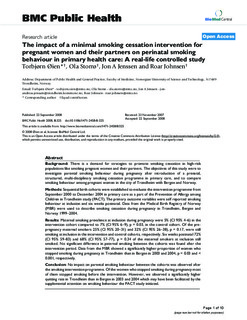The impact of a minimal smoking cessation intervention for pregnant women and their partners on perinatal smoking behaviour in primary health care: A real-life controlled study
Journal article, Peer reviewed
Permanent lenke
http://hdl.handle.net/11250/1550627Utgivelsesdato
2008Metadata
Vis full innførselSamlinger
Sammendrag
Background: There is a demand for strategies to promote smoking cessation in high-risk
populations like smoking pregnant women and their partners. The objectives of this study were to
investigate parental smoking behaviour during pregnancy after introduction of a prenatal,
structured, multi-disciplinary smoking cessation programme in primary care, and to compare
smoking behaviour among pregnant women in the city of Trondheim with Bergen and Norway.
Methods: Sequential birth cohorts were established to evaluate the intervention programme from
September 2000 to December 2004 in primary care as a part of the Prevention of Allergy among
Children in Trondheim study (PACT). The primary outcome variables were self reported smoking
behaviour at inclusion and six weeks postnatal. Data from the Medical Birth Registry of Norway
(MBR) were used to describe smoking cessation during pregnancy in Trondheim, Bergen and
Norway 1999–2004.
Results: Maternal smoking prevalence at inclusion during pregnancy were 5% (CI 95% 4–6) in the
intervention cohort compared to 7% (CI 95% 6–9), p = 0.03, in the control cohort. Of the prepregnancy
maternal smokers 25% (CI 95% 20–31) and 32% (CI 95% 26–38), p = 0.17, were still
smoking at inclusion in the intervention and control cohorts, respectively. Six weeks postnatal 72%
(CI 95% 59–83) and 68% (CI 95% 57–77), p = 0.34 of the maternal smokers at inclusion still
smoked. No significant difference in paternal smoking between the cohorts was found after the
intervention period. Data from the MBR showed a significantly higher proportion of women who
stopped smoking during pregnancy in Trondheim than in Bergen in 2003 and 2004, p = 0.03 and <
0.001, respectively.
Conclusion: No impact on parental smoking behaviour between the cohorts was observed after
the smoking intervention programme. Of the women who stopped smoking during pregnancy most
of them stopped smoking before the intervention. However, we observed a significantly higher
quitting rate in Trondheim than in Bergen in 2003 and 2004 which may have been facilitated by the
supplemental attention on smoking behaviour the PACT study initiated.
